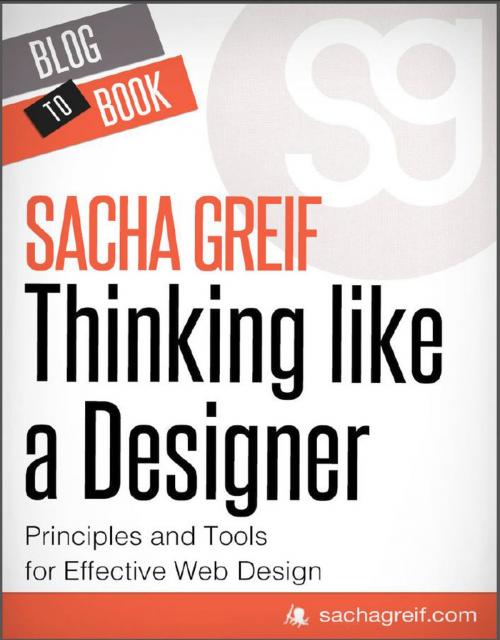Thinking Like A Designer: Principles and Tools for Effective Web Design
Business & Finance, Career Planning & Job Hunting, Entrepreneurship, Entrepreneurship & Small Business| Author: | Sacha Greif | ISBN: | 9781614645689 |
| Publisher: | Hyperink | Publication: | August 14, 2012 |
| Imprint: | Hyperink | Language: | English |
| Author: | Sacha Greif |
| ISBN: | 9781614645689 |
| Publisher: | Hyperink |
| Publication: | August 14, 2012 |
| Imprint: | Hyperink |
| Language: | English |
NOTE FROM THE AUTHOR
I have a confession to make: I call myself a designer, but I never went to design school, only worked in a web agency for a couple months, and learned what I know by reading blogs and following along tutorials.
I think this is one of the reasons why I love writing and blogging: it gives me a chance to give back and in turn help aspiring designers just like I was helped myself.
And I also blog because I want to show that although good design can often feel magical, the process itself isn't: it's just about mastering the basics, and a lot of hard work. If I can do it, I believe you probably can as well.
So what you have here is a selection of the most interesting articles I've written over the past couple years. All I hope is that they will help make a long plane ride a little bit shorter, and just maybe give you some new perspectives on design.
EXCERPT FROM THE BOOK
User Experience is a term you hear thrown around a whole lot lately. For some people it means the way a site looks and feels, for others it's all about a site's architecture, but for most of them it's just an empty buzzword that doesn't mean anything at all.
User experience is all that and much more. It literally is what users think and feel while using your product.
UX Is Everywhere
If your site has a painless sign-up process, that's part of the user experience. If your site uses gorgeous photos, that's part of the user experience. If your site is unbearably slow, that's UX too. And if your site is perfect, but there's a bug in your code and you end up charging people twice as much for your product, well guess what, that's also part of their (very bad) user experience.
So "user experience design" can include web design, photography, speed optimization, coding, to say nothing of copywriting, branding, security, interaction design, or information architecture.
We're All User Experience Designers
It logically follows that someone who calls himself a "user experience designers" should be involved in every one of those aspects. But instead, actual "user experience designers" usually come in during the early stages of a project, and use wireframes and prototypes to plan out design, architecture, and interactions. Don't get me wrong, I'm not saying it's not a real job. But I feel like it should be called something else, like maybe "Prototype Designer" or "User Experience Consultant" if the person comes in at a later stage to analyze an existing site.
In my mind, the title of "User Experience Designer" does not belong to a single person. Instead, it should be embraced by everybody contributing to the project, whether they are a designer, coder, photographer, writer, or systems administrator. Because after all, their work is what ultimately defines the user's experience.
"Can You Add More UX to It?"
Why is that important at all? Isn't all this just a question of semantics? Well, yes, it is. But bad semantics lead to bad communication, and that in turn leads to bad results. It's not uncommon to hear clients asking if you "do UX" or asking a designer if they "focus on UX." UX soon becomes an empty buzzword that can mean whatever the client wants it to mean.
User Experience Professionals have done a great job of promoting UX as a concept. But I feel it's now time that designers reclaim that term and make it clear that "UX" is not a mysterious new idea, but instead part of what every designer does every day.
Buy the book to read more!
CHAPTER OUTLINE
Introduction
+ Introduction
+ Coders Who Can't Design, Designers Who Can't Code
+ Does Design Really Matter for Start-Ups?
Design Principles
+ Design Principles
+ Why There Is No Such Thing as a UX Designer
+ Usability and the Lowest Common Denominator
+ Why wireframes can hurt your project.
+ ...and much more
...and much more
NOTE FROM THE AUTHOR
I have a confession to make: I call myself a designer, but I never went to design school, only worked in a web agency for a couple months, and learned what I know by reading blogs and following along tutorials.
I think this is one of the reasons why I love writing and blogging: it gives me a chance to give back and in turn help aspiring designers just like I was helped myself.
And I also blog because I want to show that although good design can often feel magical, the process itself isn't: it's just about mastering the basics, and a lot of hard work. If I can do it, I believe you probably can as well.
So what you have here is a selection of the most interesting articles I've written over the past couple years. All I hope is that they will help make a long plane ride a little bit shorter, and just maybe give you some new perspectives on design.
EXCERPT FROM THE BOOK
User Experience is a term you hear thrown around a whole lot lately. For some people it means the way a site looks and feels, for others it's all about a site's architecture, but for most of them it's just an empty buzzword that doesn't mean anything at all.
User experience is all that and much more. It literally is what users think and feel while using your product.
UX Is Everywhere
If your site has a painless sign-up process, that's part of the user experience. If your site uses gorgeous photos, that's part of the user experience. If your site is unbearably slow, that's UX too. And if your site is perfect, but there's a bug in your code and you end up charging people twice as much for your product, well guess what, that's also part of their (very bad) user experience.
So "user experience design" can include web design, photography, speed optimization, coding, to say nothing of copywriting, branding, security, interaction design, or information architecture.
We're All User Experience Designers
It logically follows that someone who calls himself a "user experience designers" should be involved in every one of those aspects. But instead, actual "user experience designers" usually come in during the early stages of a project, and use wireframes and prototypes to plan out design, architecture, and interactions. Don't get me wrong, I'm not saying it's not a real job. But I feel like it should be called something else, like maybe "Prototype Designer" or "User Experience Consultant" if the person comes in at a later stage to analyze an existing site.
In my mind, the title of "User Experience Designer" does not belong to a single person. Instead, it should be embraced by everybody contributing to the project, whether they are a designer, coder, photographer, writer, or systems administrator. Because after all, their work is what ultimately defines the user's experience.
"Can You Add More UX to It?"
Why is that important at all? Isn't all this just a question of semantics? Well, yes, it is. But bad semantics lead to bad communication, and that in turn leads to bad results. It's not uncommon to hear clients asking if you "do UX" or asking a designer if they "focus on UX." UX soon becomes an empty buzzword that can mean whatever the client wants it to mean.
User Experience Professionals have done a great job of promoting UX as a concept. But I feel it's now time that designers reclaim that term and make it clear that "UX" is not a mysterious new idea, but instead part of what every designer does every day.
Buy the book to read more!
CHAPTER OUTLINE
Introduction
+ Introduction
+ Coders Who Can't Design, Designers Who Can't Code
+ Does Design Really Matter for Start-Ups?
Design Principles
+ Design Principles
+ Why There Is No Such Thing as a UX Designer
+ Usability and the Lowest Common Denominator
+ Why wireframes can hurt your project.
+ ...and much more
...and much more















